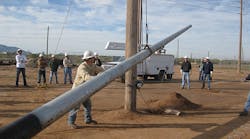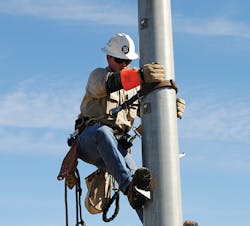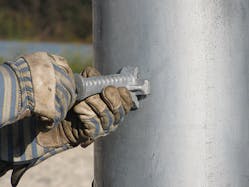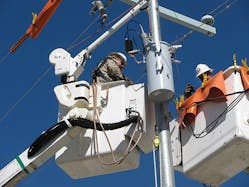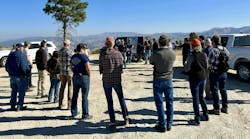In the last decade, linemen have installed more than 1 million steel distribution poles. Looking ahead, the number of steel poles going into the ground will continue to climb as electric utilities look to harden their systems, replace aging or damaged poles, and keep up with the need for new infrastructure.
When hardening their systems, electric utilities are increasingly converting their distribution systems to steel for a few key reasons. First of all, steel distribution poles are strong and durable, impervious to insects and rot, and are 100% recyclable at the end of their 80-year service lives. Unlike wood, they also do not need chemical preservative treatments, and as such, they don’t create future hazardous waste disposal concerns, according to the Steel Market Development Institute (SMDI).
Exploring Steel’s Benefits
For these reasons, more than 600 electric utility companies nationwide are using steel poles, including Bluebonnet Electric of Bastrop, Texas. As one of the largest rural electric co-ops in Texas, Bluebonnet Electric performed an economic analysis of why more utilities are turning to steel to harden their power distribution systems.
Through its research, Bluebonnet discovered steel poles save a utility 10% to 20% in life-cycle costs compared to wood poles. Thomas Ellis, the manager of engineering with Bluebonnet, says the big savings stem from the fact linemen don’t have to go back 30 years after a wood pole has been installed to replace a hard-to-reach pole. While the steel poles may cost more upfront, they last a long time, are resistant to woodpecker damage and require minimal maintenance, making them suitable for remote locations.
Other utilities across North America are considering installing steel poles, as well. For example, San Diego Gas & Electric recently proposed replacing its 69-kV wood pole structures with new weathering steel poles to increase fire safety and service reliability in a high fire risk area of San Diego County. In addition, Tucson Electric Power has been converting large parts of its predominantly wood pole system to steel poles for higher-voltage installations as part of its annual maintenance activities. As a result, the utility replaces 700 to 900 wood poles with steel distribution poles each year.
Training Linemen
This increase in steel pole installation is fueling the demand for new training and coursework for students, apprentices and journeymen linemen programs across the country. As a result, the SMDI has stepped up to support linemen training with hands-on instructional materials developed by industry professionals. In fact, over the last decade, SMDI has helped to educate more than 3,000 students, apprentices and journeymen linemen in learning safe steel pole installation and repair practices. In addition, it has sponsored 83 sessions at 29 lineman training schools, 11 utilities and 10 industry conferences.
Three years ago, SMDI connected with industry leaders in utility safety and line work training, including the Institute for Safety in Powerline Construction (ISPC) and Metropolitan Community College (MCC). With this partnership, SMDI has been able to update beginner and advanced materials for students, apprentices and journeymen.
Mack Turner, CUSP, director of operations for ISPC, has worked in the trade, and as such, he understands the need for solid training. ISPC’s mission is to reinforce safety awareness and best practices, and Turner says now that more steel poles are being installed in the field, it’s an opportune time to reinforce safety protocols and procedures in lineman training programs across the board.
Rich Newcomer, instructor for MCC’s utility line technical training program, agreed, saying the increase in steel pole installation has caused the college to expand its training program. As a result, MCC is providing students with the appropriate amount of education and situational awareness necessary to work with steel in the line.
“Our philosophy is that we give them real-world experience before they go out in the real world. Today, part of that real world is working with steel poles,” Newcomer says.
In addition, SMDI has worked closely with utilities and lineworker associations to bring hands-on training with steel in the mix. For example, SMDI and ISPC have presented steel pole training at the New Mexico Rural Electric Cooperative Superintendents’ Association Overhead Hot Line and Maintenance School in Las Cruces, New Mexico, for the last three years. This annual field training with steel poles benefits many co-op employees because it teaches them how to handle the materials, says Mike Hughes, school organizer and line superintendent of the Central New Mexico Electric Cooperative.
Offering Hands-on Instruction
In 2001, MCC in Omaha, Nebraska, was among the first lineman training schools to expand its utility line curriculum to include coursework related to steel pole installation and maintenance. This training included one-day sessions with classroom and hands-on field demonstrations.
Today, steel pole training is embedded into MCC’s overall program with classroom and hands-on activities alongside wood, concrete and other materials in the regular curriculum. For the first time, utility line students have the opportunity to install and maintain a distribution line with steel poles.
As part of the program, students who have had some basic training in pole climbing and working the trucks are assigned to small crews to build a small de-energized power line that includes both wood and steel poles. The students frame, set and work the poles in the line. When the line is completed, the crews perform routine maintenance such as reconductoring a line, and at a later date, they return to replace a pole.
“The purpose of the lineman school and the preapprentice school training is to introduce the students to the trade and provide the tools to get a really good start,” Newcomer says. “That requires a continuously improving curriculum that covers all the equipment and materials they will use as line workers.”
To improve and expand its curriculum, MCC regularly works with SMDI. Recently, Newcomer provided technical direction to SMDI in the development of updated student lineman instructional materials to add to SMDI’s growing lineman training library. All of the materials — videos, reading materials, quizzes and core competencies — are available online and in print to lineman training schools free of charge. Newcomer says the materials are useful to MCC as reinforcement to its curriculum.
“I plan to link to the new curriculum through our school’s learning management system,” Newcomer says. “Through this new curriculum, I can have the students work with the online self-study and then reinforce the lessons with hands-on work in our expanded training yard.”
Moving forward, SMDI’s primary focus is on embedding steel pole training into regular lineworker curriculum, but currently, periodic lineman training workshops with classroom and hands-on demonstrations are being offered at the top lineman training schools throughout the United States. This instruction is designed to work in tandem with the new training materials available online.
For example, the Southeastern Lineman Training Center (SLTC) in Trenton, Georgia, and Oklahoma State University’s power transmission and distribution programs include expanding classroom curriculum and day/night field work with steel distribution poles. Tim Self, director of safety and specialized training at SLTC, says the new distribution program will help linemen to fine-tune and reinforce safety practices for working with steel poles.
“The most critical part of training for line workers is a good scholastic program that gives theory and fundamentals and a strong skills-based curriculum that ensures the students are acquiring the skills as they are taught,” says Self, a utility industry veteran.
Because steel distribution poles don’t incur as much damage in harsh weather conditions or storms compared to wood, Self says they are being used more and more because of their resiliency.
“It is in students’ best interest to learn how to install and repair steel poles in a variety of situations,” Self says.
Robert Wills is vice president of construction market development for the Steel Market Development Institute.
Editor’s note: New training materials for both de-energized and energized distribution systems and safe work practices are now available through the Steel Market Development Institute. All materials are available free of charge online at lineman.steel.org. For a copy of the print version, contact Daniel Snyder.
Power Companies Turn to Steel
As more utilities are looking to harden their systems and minimize outages, many are changing out their wood poles with steel structures. For example, Westar Energy was looking for alternative materials to use for some smaller distribution projects. As the largest electric utility company in Kansas with 700,000 customers, Westar was familiar with steel poles, but its operations personnel needed additional information to install and maintain them with confidence. As such, Westar’s Safety and Training Group contacted the SMDI Steel Utility Pole Task Group to inquire about further educational opportunities offered through their organization.
Daniel Snyder, director of business development for SMDI, discussed the resources available for training Westar linemen. Westar is now investing in additional steel poles and has added steel poles to the training yard at its central training facility to allow for ongoing instruction.
Farmington Electric Utility System (FEUS) is also investing in steel structures. Owned and operated by the City of Farmington in northwest New Mexico, the utility has a service territory of 1,718 sq miles with about 2,300 miles of 15-kV distribution lines and 220 miles of 115-kV transmission lines. Until recently, FEUS lines have been 100% wood construction, and the utility spends approximately $500,000 on pole maintenance.
When a neighboring utility’s wood poles were taken out of service by a severe storm, cutting power to more than 30,000 customers, Farmington took a more focused look at system reliability and the potential of steel. For educational purposes, Valmont hosted a lineman training class focused on working with steel utility poles for FEUS and neighboring utilities. During the training, crews replaced a steel pole in an energized setting.
Linemen Learn How to Work on Live and De-energized Steel Infrastructure
With more requests for advanced training from investor-owned, cooperatives and municipal utilities, SMDI embarked on a mission to offer advanced, comprehensive training materials for journeyman and apprentice linemen. SMDI worked closely with ISPC and T&D PowerSkills to expand their considerable library of training materials to include energized distribution training focusing on steel poles.
The new training materials ISPC developed in concert with SMDI, which include a series of videos and corresponding curriculum, help to illustrate the similarities and subtle differences between steel and wood, as well as the benefits of using steel in a power distribution system.
Lineman training programs are typically aligned in two categories: de-energized, primarily for students in training, and energized. SMDI now offers training materials in both categories.
Energized Training
The energized steel pole training materials for working on energized distribution systems and safe work practices are available in a kit that includes a training manual, a DVD and a USB flash drive. This material was developed in cooperation with the Steel Market Development Institute, the Institute of Safety in Powerline Construction and T&D PowerSkills, LLC. The program covers the following topics:
• An overview of steel poles as distribution system structures
• Joining multiple-section steel poles
• Framing and setting steel poles, de-energized
• Climbing steel poles
• Energized line work, part I
• Energized line work, part II
• Additional considerations (basic insulation level)
De-Energized Training
The de-energized materials, directed primarily at students enrolled in lineman training programs in the United States, were created by SMDI working in concert with lineman training instructors. This effort was spearheaded by Rich Newcomer, lineman training director at Metropolitan Community College in Omaha, Nebraska. An instructor’s kit is available online and in print, and includes a program outline, core competencies, student reading materials, quizzes for each topic, and a companion video available in DVD and by individual chapters online. Topics covered include safety; climbing, drilling, framing and installing steel poles; field deployment of steel poles; and an overview of steel poles, including fabrication and galvanizing.
